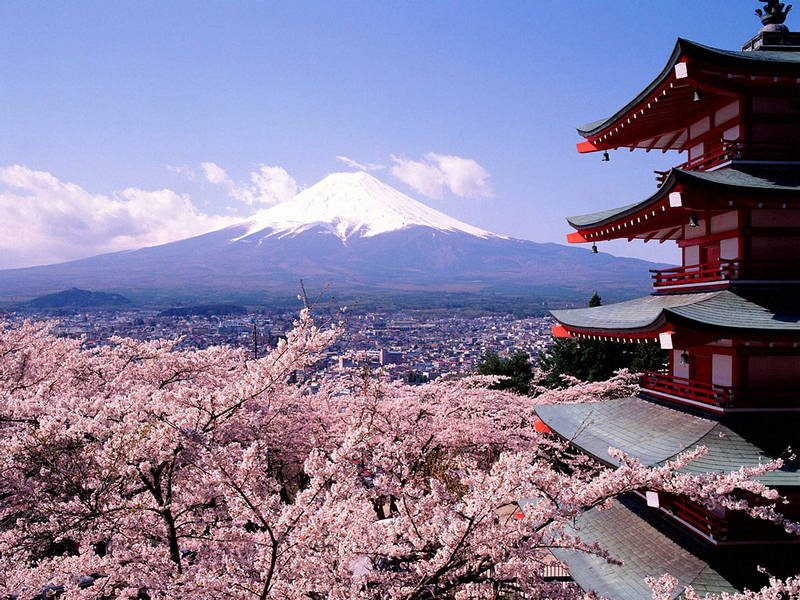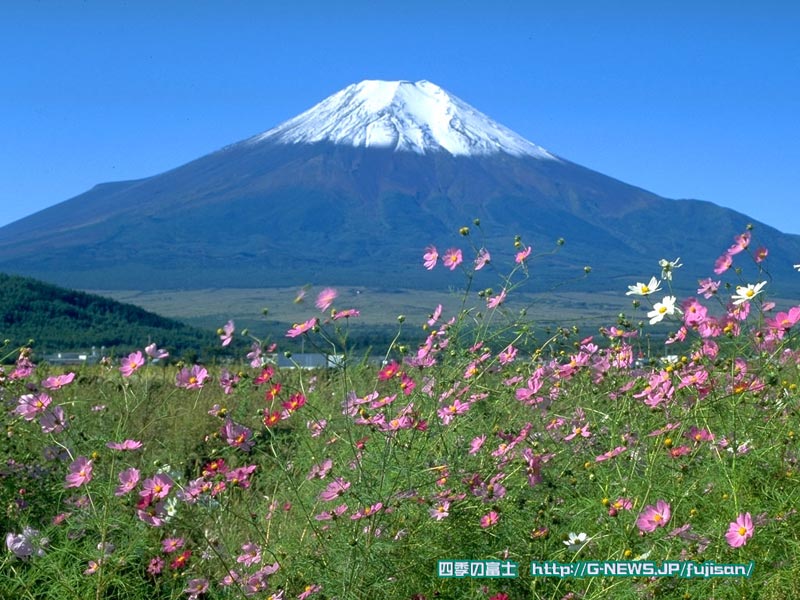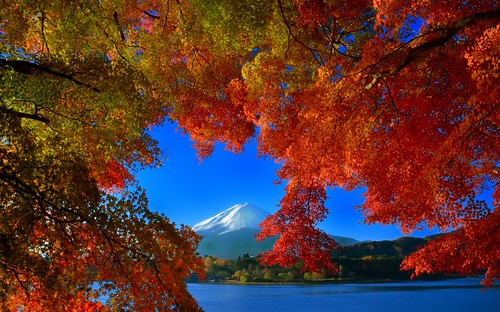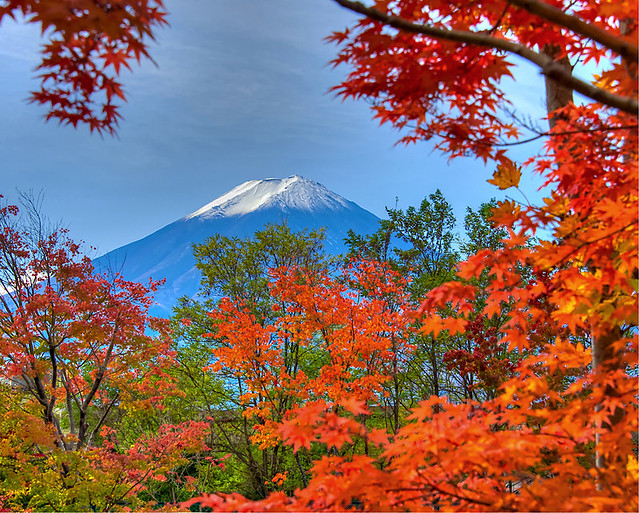Mount Fuji : The Abode Of The Buddha
Posted: Mon Aug 13, 2012 9:43 pm
Dear Members,
Mount Fuji is like the magic name, everytime we flew to Tokyo, when we were approaching Haneda Airpot our captain always announced about Mount Fuji down below and passengers would looked through the windows and take pictures.

Mount Fuji (富士山; Fuji-san in Japanese) is the tallest volcano and the highest mountain in Japan. Mount Fuji is still considered an active volcano. The current volcano, which erupted about ten thousand years ago, covers two older volcanos, Komitake Fuji and Old Fuji.

http://www.youtube.com/watch?v=Q2YoANQa ... -shelf-119" onclick="window.open(this.href);return false;
The official climbing season for Mt. Fuji is between July1 and August ...

Almost 200,000 visitors climb to its summit every year during the climbing season, from July 1 to August 27. It is also a religious center; the Shinto goddess Konohana Sakuya Hime is revered at shrines at the base and around the rim of the crater, and Buddhists called its summit “zenjo,” a Buddhist term describing a perfect meditative state. Buddhists also regard Fuji as the abode of the Buddha of All-Illuminating Wisdom
Buddha of All-Illuminating Wisdom  . Mount Fuji is a well-known symbol of Japan and is frequently depicted in art and photographs.
. Mount Fuji is a well-known symbol of Japan and is frequently depicted in art and photographs.
History
Shugendo myths relate that the first ascent of Mount Fuji was made in 663 C.E. by the wizard-sage Enno Gyoja, but it is more probable that people began ascending the mountain in the twelfth or thirteenth century. In the fourteenth century, practitioners of Shugendo (a movement worshipping the nature spirits of mountains) established the first climbing route to lead pilgrims to Fuji’s summit. Four centuries later, Fuji-ko, societies devoted to the worship of Fuji, became a major religious movement and inspired thousands of people to embark on annual pilgrimages. The summit was forbidden to women until the Meiji era; today almost half of those climbing Mount Fuji are women. The first ascent by a foreigner was made by Sir Rutherford Alcock in 1860. Today, it is a popular tourist destination and a common destination for mountain-climbing.
Mount Fuji is surrounded by myths and legends concerning its spiritual significance and resident spirits and deities. Around 800 C.E. a shrine was built at the base of the mountain to placate the fire god that caused the volcano to erupt. In the eighth-century Kojiki, the Shinto goddess Konohana Sakuya Hime, “the Goddess of the Flowering Trees,” married a god who grew jealous when she became pregnant soon after their wedding. To prove her loyalty to him, she entered a flaming bower and gave birth to a son, untouched by the flames. Sometime between the fourteenth and sixteenth centuries the belief arose that Konohana Sakuya Hime could protect the villages around Mount Fuji as she had protected her son. During the Tokugawa period (1600-1868) the Fuji-ko (Fuji mountain-climbing movement) confirmed her as the principal goddess of the mountain. Today she is still worshipped in Shinto shrines at the base and summit of Mount Fuji, including the one originally built for the fire god, and honored at a fire ceremony in Fuji-Yoshida each year at the end of the climbing season. Fuji-ko members maintain her altars in their homes, and each group lights a torch in her honor at the fire ceremony.
Buddhists found in Fuji an inspiring symbol of meditation and called its summit “zenjo,” a Buddhist term describing a perfect meditative state. Buddhists also came to regard Fuji as the abode of the Buddha of All-Illuminating Wisdom. Mount Fuji is also an important religious center; nearly two thousand religious organizations are based around the mountain, including one of Japan’s largest Buddhist sects.
The soaring volcanic cone of Mount Fuji has been a frequent subject of Japanese art. The most renowned work is Ukiyo-e painter Hokusai's masterpiece, 36 Views of Mount Fuji. It has also been mentioned in Japanese literature throughout the ages and has been the subject of countless poems.
Ancient samurai used the base of Mount Fuji as a remote training area, near the present day town of Gotemba. The shogun Minamoto no Yoritomo held yabusame in the area in the early Kamakura period. As of 2006, the Japan Self-Defense Forces and the United States Marine Corps operate military bases near Mount Fuji.
Though it is often enveloped in clouds, on a clear day, Mount Fuji can be seen from downtown Tokyo. It provides a stunning backdrop for numerous scenic drives, hot spring resort towns, tourist hotels and amusement parks.
********
 Love to look at Mount Fuji on every flight to Tokyo,
Love to look at Mount Fuji on every flight to Tokyo,
yawares
Mount Fuji is like the magic name, everytime we flew to Tokyo, when we were approaching Haneda Airpot our captain always announced about Mount Fuji down below and passengers would looked through the windows and take pictures.

Mount Fuji (富士山; Fuji-san in Japanese) is the tallest volcano and the highest mountain in Japan. Mount Fuji is still considered an active volcano. The current volcano, which erupted about ten thousand years ago, covers two older volcanos, Komitake Fuji and Old Fuji.

http://www.youtube.com/watch?v=Q2YoANQa ... -shelf-119" onclick="window.open(this.href);return false;
The official climbing season for Mt. Fuji is between July1 and August ...

Almost 200,000 visitors climb to its summit every year during the climbing season, from July 1 to August 27. It is also a religious center; the Shinto goddess Konohana Sakuya Hime is revered at shrines at the base and around the rim of the crater, and Buddhists called its summit “zenjo,” a Buddhist term describing a perfect meditative state. Buddhists also regard Fuji as the abode of the
History
Shugendo myths relate that the first ascent of Mount Fuji was made in 663 C.E. by the wizard-sage Enno Gyoja, but it is more probable that people began ascending the mountain in the twelfth or thirteenth century. In the fourteenth century, practitioners of Shugendo (a movement worshipping the nature spirits of mountains) established the first climbing route to lead pilgrims to Fuji’s summit. Four centuries later, Fuji-ko, societies devoted to the worship of Fuji, became a major religious movement and inspired thousands of people to embark on annual pilgrimages. The summit was forbidden to women until the Meiji era; today almost half of those climbing Mount Fuji are women. The first ascent by a foreigner was made by Sir Rutherford Alcock in 1860. Today, it is a popular tourist destination and a common destination for mountain-climbing.
Mount Fuji is surrounded by myths and legends concerning its spiritual significance and resident spirits and deities. Around 800 C.E. a shrine was built at the base of the mountain to placate the fire god that caused the volcano to erupt. In the eighth-century Kojiki, the Shinto goddess Konohana Sakuya Hime, “the Goddess of the Flowering Trees,” married a god who grew jealous when she became pregnant soon after their wedding. To prove her loyalty to him, she entered a flaming bower and gave birth to a son, untouched by the flames. Sometime between the fourteenth and sixteenth centuries the belief arose that Konohana Sakuya Hime could protect the villages around Mount Fuji as she had protected her son. During the Tokugawa period (1600-1868) the Fuji-ko (Fuji mountain-climbing movement) confirmed her as the principal goddess of the mountain. Today she is still worshipped in Shinto shrines at the base and summit of Mount Fuji, including the one originally built for the fire god, and honored at a fire ceremony in Fuji-Yoshida each year at the end of the climbing season. Fuji-ko members maintain her altars in their homes, and each group lights a torch in her honor at the fire ceremony.
Buddhists found in Fuji an inspiring symbol of meditation and called its summit “zenjo,” a Buddhist term describing a perfect meditative state. Buddhists also came to regard Fuji as the abode of the Buddha of All-Illuminating Wisdom. Mount Fuji is also an important religious center; nearly two thousand religious organizations are based around the mountain, including one of Japan’s largest Buddhist sects.
The soaring volcanic cone of Mount Fuji has been a frequent subject of Japanese art. The most renowned work is Ukiyo-e painter Hokusai's masterpiece, 36 Views of Mount Fuji. It has also been mentioned in Japanese literature throughout the ages and has been the subject of countless poems.
Ancient samurai used the base of Mount Fuji as a remote training area, near the present day town of Gotemba. The shogun Minamoto no Yoritomo held yabusame in the area in the early Kamakura period. As of 2006, the Japan Self-Defense Forces and the United States Marine Corps operate military bases near Mount Fuji.
Though it is often enveloped in clouds, on a clear day, Mount Fuji can be seen from downtown Tokyo. It provides a stunning backdrop for numerous scenic drives, hot spring resort towns, tourist hotels and amusement parks.
********
yawares




